Gareyev runs the table

The 63rd edition of the Iowa Open once again took place at the Mariott Hotel and Conference Center in Coralville.
Located in the southeast corner of the state, Coralville gives an impression of a typical American suburbia with its giant shopping mall (largest in the state), hotels and chain restaurants. Yet, there's a distinct feature in the otherwise standard layout, given by a man-made lake, called the Coralville Reservoir. In 1958 U.S. Army Corps of Engineers built a dam along the Iowa River to alleviate the annual flooding.
Iowa is big on rivers. The three borders, southern (the Des Moines River), eastern (The Mississippi) and western (The Missouri and higher up north, the Big Sioux River) borders are almost entirely made by rivers, and there are nice lakes along the northern border with Minnesota. The abundance of water makes Iowa an ideal farming state. The food grown in Iowa would probably be enough to sustain the entire population of the United States.
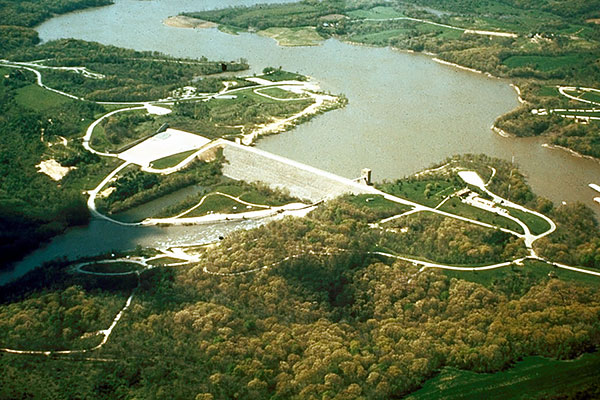
Aerial view of the Coralville Reservoir
The Mariott in Coralville, as any building does, has two sides to it. From the front, it looks like, well, nothing special.

But wait until you see the other side...

Over there the visitors find themselves looking at a nice clean pond with walkways around and across it, guarding a well-preserved wetland habitat.
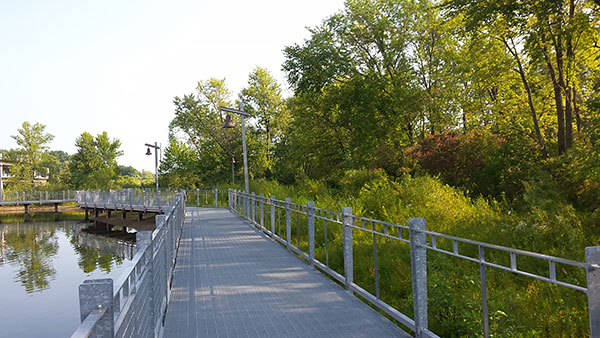
The walkways provide scenice and highly enjoyable strolls
This area provides a much-needed space for a quiet walk between games. The Conference Center is located at the far of the hotel, and I always prefer to take the pond walkway there, rather then negotiate the winding corridor inside the building.

The playing hall provided ample space for 123 participants, 83 of then in the Open Section. The event was ably run by a team of local enthusiasts, Mark Capron, Eric Vigil and Bill Broich. Thank you, guys!

Timur Gareev had a superb tournament with a perfect 5.0/5
As the reader can see the top seed Timur Gareyev (many sources have Timur's last name as “Gareev”, which is phonetically less accurate) fully redeemed himself for a last-round loss at the Twin Ports Open by simply running the table in Coralville. His last round win over Minnesota IM Sean Nagle was a smooth affair. Unfortunately I wasn't able to get a hold of the game score, so the reader will have to take my word for granted. Instead I would like to present another Gareyev win, courtesy of his gracious opponent, Dr. Okey Iwu.
| 1.e4 | 1,183,387 | 54% | 2421 | --- |
| 1.d4 | 958,449 | 55% | 2434 | --- |
| 1.Nf3 | 286,131 | 56% | 2441 | --- |
| 1.c4 | 184,608 | 56% | 2443 | --- |
| 1.g3 | 19,877 | 56% | 2427 | --- |
| 1.b3 | 14,598 | 54% | 2428 | --- |
| 1.f4 | 5,953 | 48% | 2377 | --- |
| 1.Nc3 | 3,905 | 50% | 2384 | --- |
| 1.b4 | 1,790 | 48% | 2378 | --- |
| 1.a3 | 1,249 | 54% | 2406 | --- |
| 1.e3 | 1,081 | 49% | 2409 | --- |
| 1.d3 | 969 | 50% | 2378 | --- |
| 1.g4 | 670 | 46% | 2361 | --- |
| 1.h4 | 466 | 54% | 2382 | --- |
| 1.c3 | 439 | 51% | 2425 | --- |
| 1.h3 | 289 | 56% | 2420 | --- |
| 1.a4 | 118 | 60% | 2461 | --- |
| 1.f3 | 100 | 47% | 2427 | --- |
| 1.Nh3 | 92 | 67% | 2511 | --- |
| 1.Na3 | 47 | 62% | 2476 | --- |
Please, wait...
1.d4 d5 2.c4 c6 3.Nf3 Nf6 4.Nc3 dxc4 5.e3 b5 6.a4 b4 7.Ne2!? a5?! 8.Nf4 Ba6 9.Ne5 e6 10.Qf3 Ra7?! 10...Qc7 10...c3!? 11.Bxc4 Bxc4 12.Nxc4 Be7 13.0-0 0-0 14.e4!? Qxd4! 15.Be3 Qxc4 16.Bxa7 Qxe4 16...Nbd7! 17.Qxe4 Nxe4 18.Rac1 Bg5? 19.Be3 Bf6 19...e5 20.Nd3 Bxe3 21.fxe3 f6 22.Nc5!+- 20.Nd3± Rd8 21.Rfd1 Rd5 22.Ba7 Nd7 23.Rxc6 g5 24.Rcc1 Bd4?? 25.Bxd4 25.Nxb4!+- 25...Rxd4 26.f3 Nef6 27.Nf2 Rf4 28.Ne4 Rf5 29.Rc8+ Kg7 30.Rc7 Ne5 31.Nd6 Rf4 32.Rc5 Nd5 33.Rxa5 Ne3 34.Re1 34.Re1 N5c4 35.Rxg5+ Kf6 36.Rc5+- 1–0 - Start an analysis engine:
- Try maximizing the board:
- Use the four cursor keys to replay the game. Make moves to analyse yourself.
- Press Ctrl-B to rotate the board.
- Drag the split bars between window panes.
- Download&Clip PGN/GIF/FEN/QR Codes. Share the game.
- Games viewed here will automatically be stored in your cloud clipboard (if you are logged in). Use the cloud clipboard also in ChessBase.
- Create an account to access the games cloud.
| Gareyev,T | - | Iwu,O | - | 1–0 | 2017 | D15 | 63. Iowa Open | 3 |
Please, wait...
The videos on this DVD give White a repertoire with concrete variations against all main lines Black can play and also show the typical strategic and tactical ideas of the Slav and the hidden subtleties of the position.
Accompanying Dr. Iwu on the road trip were the “Dane Brothers”...
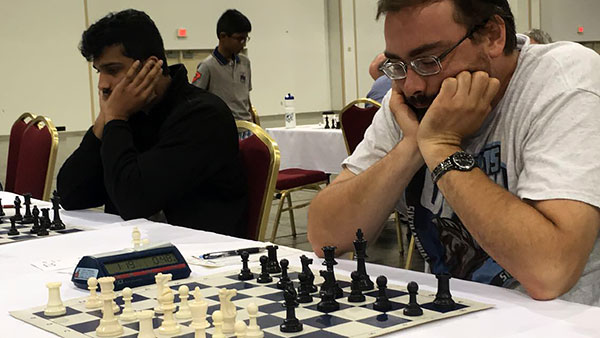
Dane Mattson coming in from Wisconsin finished with 3.0/5

Dane Zagar
...who were happy to be relieved of their organizing duties at the Twin Ports Open just a week before. One of them I met early in the tournament.
| Replay and check the LiveBook here |
Please, wait...
1.d4 Nf6 2.c4 g6 3.Nc3 d5 4.cxd5 Nxd5 5.e4 Nxc3 6.bxc3 Bg7 7.Bc4 0-0 8.Ne2 b6 8...Qd7 9.0-0 9.h4! 9...Bb7 10.f3 c5 10...Nc6 11.Be3 Na5 12.Bd3 Qd7 11.g4?! 11.Be3 cxd4 12.cxd4 Nc6 13.Rc1 Rc8 14.Qd2 e6 15.Rfd1 Qd6 11...Nc6 12.Be3 cxd4 13.cxd4 Rc8 14.Bb5?! 14.Rc1 Na5 15.Bd3 Rxc1 16.Qxc1 Nc6= 14...a6 15.Ba4 15.Bxc6 Bxc6 16.a4 b5 17.d5 Bd7 18.axb5 Bxa1 19.Qxa1 Bxb5 20.Bh6 f6 21.Bxf8 Bxe2 22.Rf2 Qb6 23.Bxe7 Bxf3 15...Na5 16.d5!? 16.Rc1 Nc4 17.Bf4 b5 18.Bb3 Qb6 16...b5 17.Bb3 Nxb3 18.axb3 e6! 18...Bxa1 19.Qxa1 f6 20.Nd4 Qd6 21.Rf2 Qe5 22.Qe1 19.dxe6? 19.Bd4 exd5 20.Bxg7 Kxg7 21.Qd4+ Kg8 22.e5 Re8 19...Bxa1! 19...fxe6 20.Bd4 e5 20.Qxa1 20.exf7+ Rxf7 21.Qxa1 Qd3 20...fxe6 21.Nd4 21.Nf4 Rc6 22.Qe5 Qf6 21...Qf6 22.g5 Qe7 23.e5 23.b4 e5 23...Rcd8 24.b4? Qxb4 25.Qa2 Rxd4 26.Qxe6+ Kh8 27.Qb6 Rg4+ 0–1 - Start an analysis engine:
- Try maximizing the board:
- Use the four cursor keys to replay the game. Make moves to analyse yourself.
- Press Ctrl-B to rotate the board.
- Drag the split bars between window panes.
- Download&Clip PGN/GIF/FEN/QR Codes. Share the game.
- Games viewed here will automatically be stored in your cloud clipboard (if you are logged in). Use the cloud clipboard also in ChessBase.
- Create an account to access the games cloud.
| Zagar,D | - | Yermolinsky,A | - | 0–1 | 2017 | D86 | Iowa Open | 2 |
Please, wait...
As usual, my tournament came down to the last game, where a win was needed to get a prize. My opponent, Missouri IM Michael Brooks, was coming off a tough game against Nagle, which was eventually drawn.
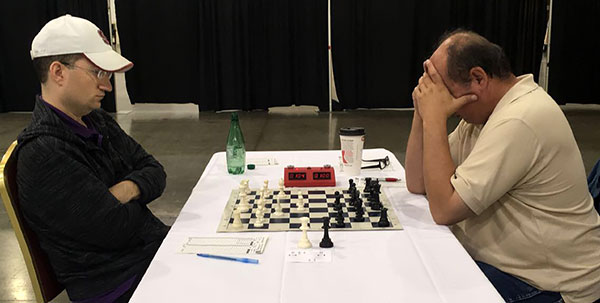
IM Sean Nagle facing IM Michael Brooks
The same result in round 4 was registered in a tough battle between Number Two seed, Priyad Kannappan and NM Valeriy Kosokin, who originally hails from Uzbekistan, which makes him Gareyev's compatriot.
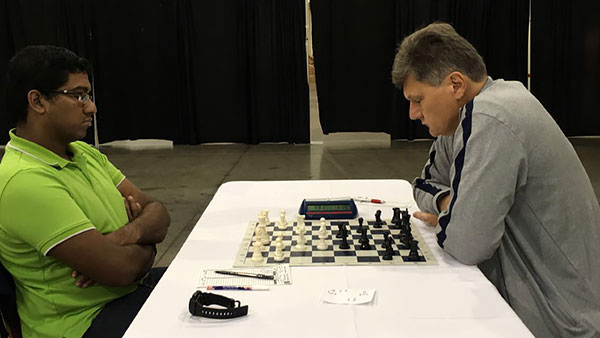
Priyad Kannappan and NM Valeriy Kosokin
In the previous editions of the Iowa Open I couldn't get by those guys, losing to Kosokin in 2015 and to Brooks in 2016. I welcomed a chance at redemption, and it turned out to be quite a nervy affair.
| Replay and check the LiveBook here |
Please, wait...
1.d4 g6!? 2.e4 d6 3.Nc3 Bg7 4.Bg5!? h6!? 4...a6 5.Qd2 5.a4 Nd7 6.Bc4 c5 7.dxc5 Nxc5 8.Nge2 5...Nd7 6.f4 b5 7.Nf3 Bb7 8.0-0-0 b4 9.Nd5 Bxd5 10.exd5 Ngf6 4...c6 5.Qd2 b5 6.f4 Nd7 5.Be3 5.Bh4 c5!? 6.dxc5 Qa5 7.Qd2 7.Bb5+ Bd7 7...Nc6 8.Nge2 dxc5 8.Bxd7+ Nxd7 9.cxd6 Bxc3+ 10.bxc3 Qxc3+ 11.Kf1 Qc4+ 12.Qd3 Rc8 7...Bxc3! 7...Qxc5 8.Bd3 Nf6 9.f4 Nc6 10.Nge2 8.bxc3 g5 9.Bg3 Qxc5 10.Qd4 Qxd4 11.cxd4 f5 5...Nd7 6.Qd2 a6 7.a4 e6 8.Nf3 b6 9.Bc4 Ne7 9...Ngf6 10.d5 exd5 10...e5!? 11.Bxd5 Nxd5 12.exd5 10.0-0 Bb7 11.Rfe1! 11...g5 11...d5 12.exd5 exd5 13.Nxd5 Nxd5 14.Bg5+ 11...c6!? 12.d5! e5 12...Bxc3 13.Qxc3 e5 14.h4 g4 15.Nh2 h5 16.Nf1 Ng6 17.g3 13.Ne2 f5!? 13...0-0 14.h4! g4 15.Nh2 14.exf5 Nxf5 15.Ned4! Qf6 16.Ne6 Kf7 16...g4 17.Nfd4! exd4 18.Nxg7+ Kf7 19.Nxf5+- 17.Qe2 Rhc8 18.g4!? 18.Nd2 Kg8 19.Ne4 Qg6 20.Qg4 Nf8 21.Nxg7 Kxg7 22.Ng3 18...Ne7 18...Nxe3 19.fxe3 Kg8 20.Nd2 Qe7 21.Ne4 Nf8 22.Ng3 19.Nfxg5+ 19...Kg8! 19...hxg5 20.Bxg5 Qg6 21.Bd3 20.Nxg7 Kxg7 21.Ne6+?! 21.Ne4 Qg6 22.Rad1 21...Kh8 22.g5 Rg8 23.Kf1? 23.Qg4 Nxd5 24.Rad1 23...Qf7 23...Qf5 24.Qh5 24.Qd3 Qh5 24...Nf8! 25.Nxc7 Rc8 26.Bxb6 Rxg5 25.Rad1 25...hxg5?! 25...b5 26.Ba2 25...Nf8! 26.Nxc7 Rc8 27.Bxb6 Nd7 28.a5 Rxg5 29.Re3 Nf5 30.Rh3 Qg4 26.Bxg5 Nc5?? 26...Rxg5! 27.Nxg5 Nc5 28.Qh3 Qxh3+ 29.Nxh3 Nxa4 30.Bb3 Nc5 31.Ba2 a5 32.Nf4 32.f4 Rf8 33.Kg2 Bc8 32...Rf8 33.Nd3 27.Bf6+ 1–0 - Start an analysis engine:
- Try maximizing the board:
- Use the four cursor keys to replay the game. Make moves to analyse yourself.
- Press Ctrl-B to rotate the board.
- Drag the split bars between window panes.
- Download&Clip PGN/GIF/FEN/QR Codes. Share the game.
- Games viewed here will automatically be stored in your cloud clipboard (if you are logged in). Use the cloud clipboard also in ChessBase.
- Create an account to access the games cloud.
| Yermolinsky,A | - | Brooks,M | - | 1–0 | 2017 | B06 | Iowa Open | 5 |
Please, wait...
The Iowans are recognized by their communal spirit. The state boasts excellent infrastructure, well-maintained highways, and plenty of public parks. One question is, where's the chess? Indeed, out of a population of three million, Iowa doesn't have a single Grandmaster or International Master among its denizens. The situation needs to be rectified. Come on, my fellow Grandmasters, pack your moving vans, leave crowded coastal cities with their high cost of living, and relocate to the heart of the country. Trust me, you won't regret it.
One last look at the water...

There is always something enjoyable about capturing a fine reflection in the water
Links














